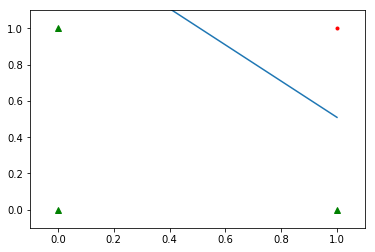一丶作业要求
| 标题 | 内容 |
|---|---|
| 这个作业属于哪个课程 | 班级博客的链接 |
| 这个作业的要求在哪里 | 作业要求的链接 |
| 我在这个课程的目标是 | 完成一个完整的项目,学以致用 |
| 这个作业在哪个具体方面帮助我实现目标 | 帮助我了解反向传播 |
二、解决方法
1) 训练一个逻辑与门和逻辑或门
有时候不想写太多函数,几行就够了。
以下为Sigmoid + learning_rate = 1.
import numpy as np
np.random.seed(42)
X_and = np.array([[0, 0],[0, 1],[1, 0],[1, 1]])
y_and = np.array([0, 0, 0, 1])
y_and_one_hot = np.zeros((4, 2))
y_and_one_hot[np.arange(4),y_and]=1
weights = np.sqrt(2/3)*np.random.randn(2, 2)
bias = np.ones((1, 2))
loss = np.infty
while loss > 1e-2:
output = 1/(1 + np.exp(-np.dot(X_and, weights)-bias))
weights -= np.dot(X_and.T ,(output - y_and_one_hot))
bias -= np.mean(output-y_and_one_hot, axis=0, keepdims=True)
loss = -np.mean(np.log(output)*y_and_one_hot)
#output:
#array([[9.99980695e-01, 1.99816334e-05],
# [9.75014897e-01, 2.52661750e-02],
# [9.75014897e-01, 2.52661750e-02],
# [2.85591765e-02, 9.71119454e-01]])
#loss:0.009991269981324791
X_or = np.array([[0, 0],[0, 1],[1, 0],[1, 1]])
y_or = np.array([0, 1, 1, 1])
y_or_one_hot = np.zeros((4, 2))
y_or_one_hot[np.arange(4),y_or]=1
weights = np.sqrt(2/3)*np.random.randn(2, 2)
bias = np.ones((1, 2))
loss = np.infty
while loss > 1e-2:
output = 1/(1 + np.exp(-np.dot(X_or, weights)-bias))
weights -= np.dot(X_or.T ,(output - y_or_one_hot))
bias -= np.mean(output-y_or_one_hot, axis=0, keepdims=True)
loss = -np.mean(np.log(output[np.arange(4), y_or]))
#output
#array([[9.73856986e-01, 2.69389503e-02],
# [6.49497719e-03, 9.93314951e-01],
# [6.48613192e-03, 9.93311743e-01],
# [1.14572236e-06, 9.99998745e-01]])
#loss:0.0099775725983246262)二分类可视化
core code
def ShowData(X,Y, W, B):
for i in range(X.shape[0]):
if Y[i,0] == 0:
plt.plot(X[i,0], X[i,1], '.', c='r')
elif Y[i,0] == 1:
plt.plot(X[i,0], X[i,1], '^', c='g')
# end if
# end for
plt.axis([-0.1, 1.1, -0.1, 1.1])
w12 = -W[0,0]/W[1,0]
b12 = -B[0,0]/W[1,0]
x = np.linspace(0,1,10)
y = x*w12 + b12
plt.plot(x,y)
plt.show()与门:

或门:

3)经典多分类svm
def svm_loss(x, y):
"""
Computes the loss and gradient using for multiclass SVM classification.
Inputs:
- x: Input data, of shape (N, C) where x[i, j] is the score for the jth
class for the ith input.
- y: Vector of labels, of shape (N,) where y[i] is the label for x[i] and
0 <= y[i] < C
Returns a tuple of:
- loss: Scalar giving the loss
- dx: Gradient of the loss with respect to x
"""
N = x.shape[0]
correct_class_scores = x[np.arange(N), y]
margins = np.maximum(0, x - correct_class_scores[:, np.newaxis] + 1.0)
margins[np.arange(N), y] = 0
loss = np.sum(margins) / N
num_pos = np.sum(margins > 0, axis=1)
dx = np.zeros_like(x)
dx[margins > 0] = 1
dx[np.arange(N), y] -= num_pos
dx /= N
return loss, dx